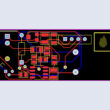The digital ALS is a newly designed Ambient Light Sensor based on chip OPT4001 by Texas instruments, better than existing ambient light sensors in terms of precision and speed. This device measures light with a precision optical filtering to closely match the human eye with excellent near-infrared (IR) rejection.

Hardware Components:
| 1. | Green LED 0805 | x1 |
| 2. | Blue LED 0603 | x1 |
| 3. | Red LED 0805 | x1 |
| 4. | Vertical Pin Header 5 pins | x1 |
| 5. | Conn USB Type C | x1 |
| 6. | Resistor 0 ohm | x9 |
| 7. | Resistor 620 ohm | x1 |
| 8. | Resistor 47k ohm | x1 |
| 9. | Resistor 1.5k ohm | x1 |
| 10. | Resistor 100 ohm | x1 |
| 11. | Resistor 1M ohm | x1 |
| 12. | Resistor 4.7k ohm | x3 |
| 13. | SWITCH | x1 |
| 14. | TPD2E001 | x1 |
| 15. | Conn DIP Socket SKT 8 POS | x1 |
| 16. | LDO Regulator | x1 |
| 17. | CRYSTAL | x1 |
| 18. | MSP430F5503IRGZR | x1 |
| 19. | Light Sensor OPT4001 | x1 |
| 20. | Capacitor 1000pF | x1 |
| 21. | Capacitor 10pF | x2 |
| 22. | Capacitor 1uF 0402 | x1 |
| 23. | Capacitor 100nF | x3 |
| 24. | Capacitor 10uF | x2 |
| 25. | Capacitor 1uF 1206 | x1 |
| 26. | Connector Terminal POS 1 | x24 |
Software Tools:
- Inventhub
- Altium Designer
What is a Digital Ambient Light sensor?
The digital ambient light sensor is used to control the brightness of the electronic devices according to the level of light in the surroundings. Ambient light sensors are used in a wide variety of applications that require precise measurement of light as perceived by the human eye since they have a specialized filter that mimics the human eye. It is mostly used in smartphones, smartwatches, and other wearable electronics.

OPT4001 measures the ambient light that illuminates the device. This device measures light with a spectral response very closely matched to the human eye, and with very good infrared rejection. Matching the sensor spectral response to that of the human eye response is vital because ambient light sensors are used to measure and help create ideal human lighting experiences. Strong rejection of infrared light, which a human does not see, is a crucial component of this matching. This matching makes the OPT4001 especially good for operation underneath windows that are visibly dark, but infrared transmissive.
Introduction to OPT4001:

The OPT4001 is a light to a digital sensor that measures the intensity of visible light. The spectral response of the sensor tightly matches the photopic response of the human eye. A specially engineered filter on the device rejects near-infrared components from the common light sources to measure accurate light intensity.
The OPT4001 is designed for systems that require light level detection to enhance user experience and typically replaces low-accuracy photodiodes diodes, photo-resistors and other ambient light sensors with underwhelming human eye matching and near infra-red rejection.

OPT4001 device can be configured to operate with light conversion times all the way from 600µs to 800ms in 12 steps, providing system flexibility based on application needs. Conversion time includes the light integration time and ADC conversion time. The resolution of the measurement is determined by the light intensity and the integration time, effectively bringing in the capability to measure down to 312.5µlux of light intensity changes.
The digital operation is flexible for system integration. Measurements can be either continuous or triggered in one shot with a register write. The digital output is reported over an I2C- and SMBus compatible, two-wire serial interface. An internal FIFO on output registers along with burst mode I2C support helps minimize interrupts and processing power required by the I2C controller.
The low power consumption and low power-supply voltage capability of the OPT4001 help enhance the battery life of battery-powered systems.

Board Features:
- Spectral matching to Human eye: The OPT4001 board has better infrared light rejection. Its spectral response closely matches that of the human eye.
- Automatic Full-Scale Range Setting: This board has an automatic full-scale range setting feature that eliminates the need to predict and set the optimal range for the device. In this mode, the device automatically selects the optimal full-scale range for varying lighting conditions for each measurement. The device has a high degree of result matching between the full-scale range settings. This matching eliminates the problem of varying results or the need for range-specific, user-calibrated gain factors when different full-scale ranges are chosen.
- Output Register: This board consists of an additional bit that is the output register which helps in improving the reliability of light measurements for the application.
- Threshold Detection: The OPT4001 board has the feature of detecting the threshold point for any level indication. There are independent low and high threshold target registers with independent flag registers to indicate the status of the measured light level. Measured light levels reaching below the low threshold and above the high threshold are called faults. Therefore, this board can detect the faults in it as per the threshold point of the light.
Modes of Operation:
There are three modes of operation available on this board:
- Power down mode
- Continuous mode
- One-shot mode
Existing Light Sensor Devices:
- AMIS74980x ambient light sensor: This light sensor is based on AMIS74980. It approximates human eye response. As compared to the OPT4001 it is less precise. It works on both analog and digital output. This provides a low power design with a standby current of 1uA while OPT4001 provides a standby current of 2uA at an ultra low power design.
- APDS-9004: This device is an analog output ambient light sensor. It consists of a photosensor that detects the level of light in the surroundings and adjusts the light according to it. As it provides analog output so it is less accurate as compared to the OPT4001 module.
Comparison:
In comparison with existing devices, OPT4001 is the most accurate, high speed, and highly precise light to the digital conversion module with the I2C interface. It provides a low operating current of 30 μA with ultra-low power standby of 2 μA. It has 28 bits of effective dynamic range from 312.5 μlux to 83 Klux. This board provides high precision measurements, for instance, up to 40 mlux resolution at 6.5 ms and 2.5 mlux at 100 ms conversion times.
Circuit Design:
This OPT4001 evaluation board consists of three parts:
- Flex Coupon board: It is a flex PCB that contains OPT4001 IC. This flex board is soldered onto a rigid coupon board for added stability.
- Rigid Coupon board: The rigid coupon board contains 8 pins which allow it to plug into a socket on the motherboard.
- Motherboard: The motherboard contains an MSP430 microcontroller and plugs into a PC through the provided USB cable.
To set up and test this board, first install OPT4001EVM GUI software on your computer. For further installation information please refer to OPT4001YMNEVM User’s Guide by TI.
This board can be attached with smartwatches, health fitness bands, and smartphones. Embed the GUI software in the board using a computer and USB cable and use it with your devices. This will help in making your smart device friendly in different kinds of environments and light levels.
Designing of Board:
I have designed a board based on OPT4001 for smart electronic devices to control the brightness of light as per the environmental effect. This board uses a two-wire interface that works with the I2C protocol making it ideal for many applications. The board has an automatic full-scale-range setting mode that eliminates the need for a user to predict and set the optimal range for the device.
Schematic file:
I have uploaded the schematic file online on Inventhub. The schematic is split into three sections: connector, MSP430, and socket. A USB type C connector is used to interface with the PC. The MSP430 microcontroller allows the PC to interface with the OPT3004DTS through I2C. The coupon board containing the OPT4001 plugs into the motherboard through the socket. The OPTMBEVM(Motherboard) board provides easy access to the I2C, INT, VDD, and GND lines.



PCB file:
For fabrication, I have uploaded all my PCB files of the design on Inventhub. I can view the board in different layers and can focus on a specific layer of the board. Instead of visiting the manufacturer, I can send him this file, he can view or download it and can fabricate my board.



BOM file:
After fabrication, I need components to get finalized my board, for this, I have created a Bill of Material(BOM) of my components on Inventhub that contains the dimensions of all my components with footprints. I can also calculate the total cost of my project by clicking on the ‘Edit BOM’ and enabling the ‘Supply Chain’ button. Our total cost is $30. The component provider will only export that file in CSV format and can deliver the same components as I required for my design.

Applications:
Ambient light sensors are used in a wide variety of applications that require precise measurement of light as perceived by the human eye since they have a specialized filter that mimics the human eye. This OPT4001 evaluation board has wide applications like:
- Display backlight controls for:
- Smartwatch
- Smart Phones
- Wearable electronics
- Health fitness bands
Summary:
This ambient light sensor board based on OPT4001 can be used in your components like smart and wearable watches and bands and smartphones etc. It consists of a photodetector that will detect the amount of ambient light in a device and will adjust it according to the environment. It will make your device user-friendly and the user can use it anywhere in any environment i.e. intensity of light. This board is more precise and highly accurate as compared to existing ALS devices.








